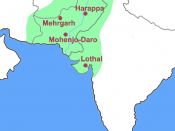Mesopotamia and Harappan societies have long been compared throughout the history of archaeology. Mesopotamia, also known as, 'the land between the rivers,' was named for the triangular area between the Tigris and the Euphrates river, (Nov. 7 lecture). In recent use, it covers a broader area referring to most of what is now Iraq. This adds ancient Assyria and Babylonia to the scope of Mesopotamia (Schultz and Lavenda 1995:310). Parts of Mesopotamia were not inhabited at all until approximately 8000 BC when plants and animals were domesticated, bringing about an agricultural revolution. This allowed nomads and cave dwellers to become farmers and herders.(Whitehouse 1977:129).)
The Indus civilization is often referred to as Harappan civilization from one of the major sights called Harappa. The Indus civilization existed in South Asia from about 2700 BC to 1750 BC.(Hawkes 1973:49). Smaller groups lived in the area before this time, but it is around 2700 BC when the typical Indus cities took place.(Hawkes
1973:53).
These two territories had many things in common, but also differed in some fundamental ways. The economies of both will be analyzed from information available to date, as well as the forms of government and rule that each employed. Next, the social structure of Mesopotamia and the Indus civiliation will be compared, focussing on social stratification and employment. Finally, I will discuss the architecture of these two ancient sights and the innovations created or similar materials used.
ECONOMY
The economy of Mesopotamia was mainly agricultural, but also included wool, hair, and leather. (Oppenheim 1977:83). The domestication of animals, painting of pottery, and most importantly agriculture spread to Greece from Mesopotamia, showing the great influence it had on surrounding areas. (Caldwell 1987:18). This agriculture was being jeopardized from the progressive salinization of the soil, and the weakening of the dikes.


